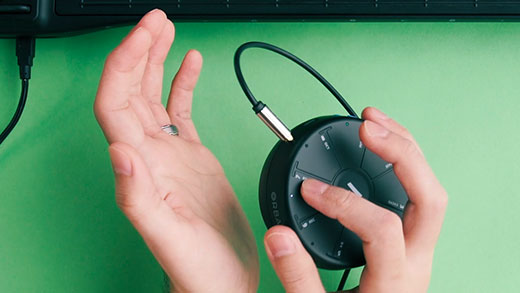
If you’ve updated your Orba in the past week, you may have noticed we debuted a new and improved shaker sound! We thought you’d enjoy hearing the story behind the upgrade.
Orba’s shaker sound has always had a special voice. Because Orba uses an internal synthesizer rather than pre-recorded samples of real world instruments, we had to get creative for how we would approach this.
Try Shake by entering Drum Mode, holding Pad 8, and shaking Orba from side to side.
Orba uses a form of physical modeling to synthesize its sounds. Normally, a physical modeling synthesizer imitates sounds like vibrating strings, pipes, or membranes by accurately simulating the physics of the acoustic instruments that produce them. So how could we apply this technology to the creation of a shaker synth?
First, we thought carefully about the physics of a real shaker and observed what happens when a physical shaker is played.
The small beans or seeds inside a shaker not only collide with the shell, but also slide against the shell and bump into each other. While adding random bursts of noise did a reasonable job of mimicking the most prominent source of acoustic energy in the shaker, some amount of additional background noise was needed to mimic all of the other random motion inside the shaker. It was also important for the statistical distribution of the noise signal to roughly approximate the “bell curve” of random processes found in nature, rather than a uniform distribution which is easier to generate in a computer program. Whew.
🤓
So, we began by tweaking Orba’s synth to mimic those physical behaviors and finding a fun balance between predictability and organic responsiveness.
It turns out, a physical shaker has more than one acoustic resonance. Acoustic waves can travel in the air inside the shaker’s cavity, and also along the material of the shell. In addition, because shakers (usually) aren’t perfectly spherical, the frequency responses of both the internal cavity and the shell surface are more complex than a simple resonant filter. Adding a second resonant filter to the shaker synth created a more complex frequency response, which gave the shaker synth a more nuanced tone.
Finally, in firmware, we adjusted the interaction between Orba’s Shake gesture and the shaker synth. The Shake gesture now has greater dynamic range, and the gesture’s impact on the level and average frequency of the randomized noise bursts is more natural.
The latest Orba update includes this upgraded shaker, as well as other general improvements. You can download it by updating your device in the Orba app, following the instructions here.
And, there are plenty of other Gestures! Learn about Tap, Tilt, and Radiate in the video above.

